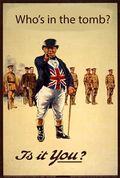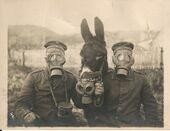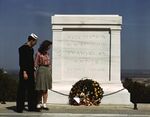Tomb of the Unknown Soldier
The Tomb of the Unknown Soldier is a symbolic shrine that houses the body of an unidentified soldier. The soldier could be anyone. Who knows? it could be Great-great-uncle Johnson or the long lost relative of the bloke you met at the pub last weekend who owned that cute spaniel called Julie. Quite literally, it could be anyone, provided that the anyone was killed horribly in war and the body was so disfigured it was impossible to identify.
Background[edit]
War is really not that much fun, especially for those who are killed in the line of duty. Even for those who survive it really isn't much more fun living on with the memories and physical scars unless you happened to be a commanding officer of some description that was able to serve your country from behind a desk somewhere cosy and safe with a well stocked drinks cabinet.
World War I is the classic example of how unpleasant war can be when the prevailing military tactic was to run en masse towards well defended enemy positions simply to be mown down in your tracks in a hail of lead resulting in millions of bodies piling up and decaying in the fields of war. With so many bodies in such bad condition it was either impossible or impractical to positively identify each individual let alone return every single body back to relatives. At the end of this war after nothing had been achieved a great many families of the dead really started to question the benefits of war particularly when not even a little bit of the body of their loved one had been returned for burial. This type of unrest could have led to an uprising and the possibility that the masses would refuse to go to war again so the military came up with the cracking idea of the Tomb of the Unknown Soldier.
Finally, a win for everyone[edit]
It terms of military success the Tomb of the Unknown Soldier was an absolute stroke of genius. By digging up a single unidentified body and entombing it in a magnificent monument on home ground somehow the majority of families were placated as everyone felt that the body in the tomb was their own missing relative regardless of the odds of that actually being reality. The masses thronged to the opening ceremonies and nationalistic pride was restored. The Tomb of the Unknown Soldier was so popular that pretty much every country got on the band wagon and erected one of their own following World War I. Some countries got really enthusiastic and erected several monuments, some of which are located in enemy territory which is a little baffling.
Viewing this behaviour from a detached distance with the benefits of hindsight and an education above grade 5 it seems impossible to believe that a monument of this type was so endearing to the common folk, but hey, that's humans for you, they're just full of surprises.
Remembrance Days[edit]
In most countries the Tomb of the Unknown Soldier is a key focus on days set aside to glorify past wars and the associated war dead. There's nothing funny about the fact that tens of millions of people have been slaughtered in wars over the years in what boils down to the ideological motivation of a handful of nut jobs but everyone loves a good party, especially if you can have a good cry, revel in the past and get pissed.
Modern Day - The death knell of the monument[edit]
In our modern and caring society relatives of military personnel inevitably want the dead body of their loved one returned home regardless of what bits are missing. This poses a number logistical problems in cases where multiple fatalities occur in a relatively confined area as it's often impossible to know which bit belonged to whom just using the naked eye. However, advances in DNA testing through the 1950's has led to a range of relatively simple tests and the bits can now be separated into discrete piles, bagged up and returned to relatives. Often they're not very large bags, sometimes a simple zip lock lunch baggy will do, but at least relatives can have what's left to assist with the grieving process before the issues of compensation are thrashed out.
The downside of DNA testing body parts is that all dead military personnel are now positively identified so a Tomb of The Unknown Soldier has not been commissioned since the second world war and it's highly unlikely another one will ever be created. Some military enthusiasts have suggested the creation of a Tomb of the Missing Soldier because often bodies go missing for all sorts of reasons. Opponents to this idea believe "Missing" doesn't really have the same poignancy or mystique as "Unknown" and there wouldn't be an actual body in the tomb. A further suggestion is the Tomb of the Vapourised Soldier placing gas captured from the incident site in the tomb but then the name of the soldier(s) would still be known. It's a problem that the military continue to work through to this day.
The enormous elephant in the tomb is DNA testing the bodies contained in existing tombs. Great grand children and beyond are understandably curious as to where their ancestors remains are located. For some it's a puzzle that cannot be left unresolved but given that there are hundreds of thousands of unmarked war graves scattered around the world the scale of the task is overwhelming. An easy option to begin with that doesn't require going anywhere foreign is to lobby government to allow DNA testing of local unknown soldier tombs. It's a long shot, probably more than 1:900,000 for most people but still it's better odds than being struck by lightning. There are currently forty-two cases worldwide either with the respective Defence Departments or petitions in respective courts of law seeking permission to DNA test various tombs. To date none have been successful but it's only a matter of time and once the first tomb falls they'll be cracking them open like walnuts at Christmas. These actions could spell the complete demise of the Tomb of the Unknown Soldier.


